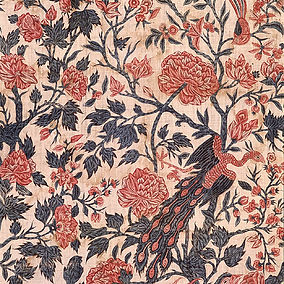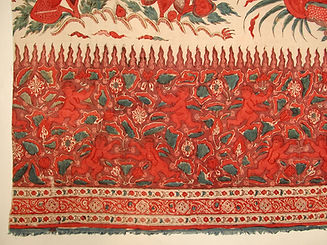A (very) brief description of Chnitz and modern-day interpretations

Palampore made from Indian Chintz (coastal Southeastern India - circa 1750). Hand-painted and hand-dyed.
A palampore is chintz fabric used as a wall-hanging or a bedspread. This piece is a wall hanging that was likely produced for the European market.
Many of us know chintz as a common floral patterned and printed cloth used to create dresses, jackets and furnishings. But did you know that chintz originated in the southeastern coastal region of the Indian sub-continent known as the Coromandel Coast?
The origin of the word “chintz” is the Hindi word “cheent” which means speckled, sprayed or spotted.
Originally created to adorn palace walls in India these popular fabrics featured a variety of bold patterns and striking colors - from stylized floral motifs to complex themes depicting nature or battle scenes. These were hand-painted or printed by highly skilled artisans that used sophisticated techniques and hand-skills,
Chintz's Rise and Decline
Like with other cottons from India, this vibrantly colored and patterned fabric became wildly popular in Southeast Asia, the Indian sub-continent, Europe and other parts of the world. Over the years, Indian chintz was coveted as fabric for fashionable dresses and luxury furnishings.
Like with other cotton exports from India, manufacturers in other parts of the world, especially Europe, created their own printed versions of chintz as they felt threatened by the massive demand for Indian chintz in their own countries. European manufacturers began printing their own chintz designs, and the fabric became so popular as to earn the nickname "chintzy". Yes, this is, indeed the origin of the word!
Where is Indian Chintz today?
While there are several attempts to revive Indian chintz today, they exist in slightly different forms: in the art of "kalamkari" (drawing with a pen) and in hand-block-printing. The designs that evoke memories of the popular Indian chintz of yore, however, are primarily block-printed, Kalamkari focuses on traditional designs, though this is changing. Hand-drawing the beautiful chintz designs has captured the imagination of a few young designers today and they are attempting to revive these ancient techniques.
Stay tuned for specimens of kalamkari and hand-block-printing on these pages. In the (not so) chintzy style of yesteryear, of course!.



"The desire to possess, and later to imitate Indian chintz transformed the arts, industries, and economies of 5 countries, with reverberations still felt today" - Sara Fee, Senior Curator, Global Fashion & Textiles (Asia and Africa)
